JEEP GRAND CHEROKEE 2013 Owner handbook (in English)
Manufacturer: JEEP, Model Year: 2013, Model line: GRAND CHEROKEE, Model: JEEP GRAND CHEROKEE 2013Pages: 408, PDF Size: 3.21 MB
Page 51 of 408
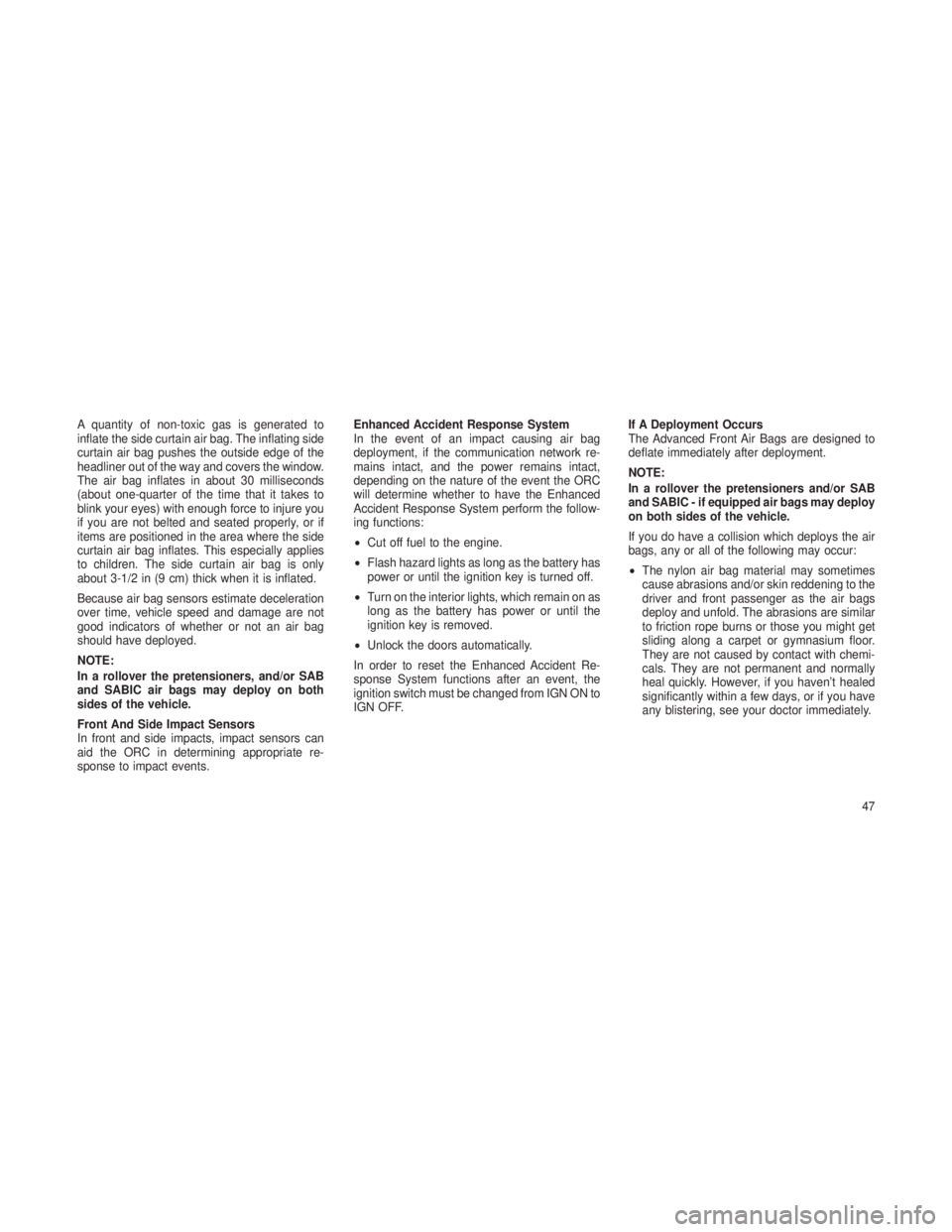
A quantity of non-toxic gas is generated to
inflate the side curtain air bag. The inflating side
curtain air bag pushes the outside edge of the
headliner out of the way and covers the window.
The air bag inflates in about 30 milliseconds
(about one-quarter of the time that it takes to
blink your eyes) with enough force to injure you
if you are not belted and seated properly, or if
items are positioned in the area where the side
curtain air bag inflates. This especially applies
to children. The side curtain air bag is only
about 3-1/2 in (9 cm) thick when it is inflated.
Because air bag sensors estimate deceleration
over time, vehicle speed and damage are not
good indicators of whether or not an air bag
should have deployed.
NOTE:
In a rollover the pretensioners, and/or SAB
and SABIC air bags may deploy on both
sides of the vehicle.
Front And Side Impact Sensors
In front and side impacts, impact sensors can
aid the ORC in determining appropriate re-
sponse to impact events.Enhanced Accident Response System
In the event of an impact causing air bag
deployment, if the communication network re-
mains intact, and the power remains intact,
depending on the nature of the event the ORC
will determine whether to have the Enhanced
Accident Response System perform the follow-
ing functions:
•
Cut off fuel to the engine.
• Flash hazard lights as long as the battery has
power or until the ignition key is turned off.
• Turn on the interior lights, which remain on as
long as the battery has power or until the
ignition key is removed.
• Unlock the doors automatically.
In order to reset the Enhanced Accident Re-
sponse System functions after an event, the
ignition switch must be changed from IGN ON to
IGN OFF. If A Deployment Occurs
The Advanced Front Air Bags are designed to
deflate immediately after deployment.
NOTE:
In a rollover the pretensioners and/or SAB
and SABIC - if equipped air bags may deploy
on both sides of the vehicle.
If you do have a collision which deploys the air
bags, any or all of the following may occur:
•
The nylon air bag material may sometimes
cause abrasions and/or skin reddening to the
driver and front passenger as the air bags
deploy and unfold. The abrasions are similar
to friction rope burns or those you might get
sliding along a carpet or gymnasium floor.
They are not caused by contact with chemi-
cals. They are not permanent and normally
heal quickly. However, if you haven’t healed
significantly within a few days, or if you have
any blistering, see your doctor immediately.
47
Page 52 of 408
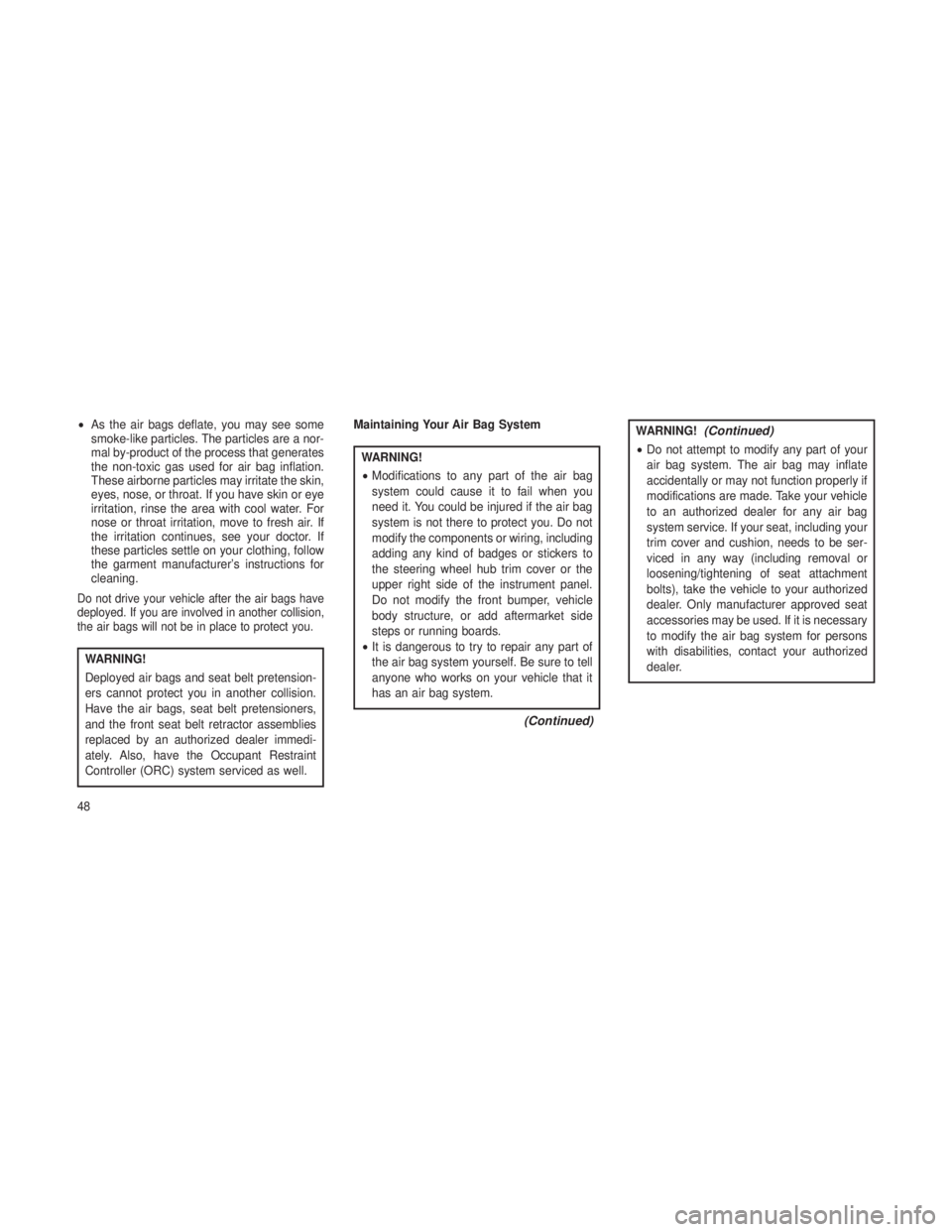
•As the air bags deflate, you may see some
smoke-like particles. The particles are a nor-
mal by-product of the process that generates
the non-toxic gas used for air bag inflation.
These airborne particles may irritate the skin,
eyes, nose, or throat. If you have skin or eye
irritation, rinse the area with cool water. For
nose or throat irritation, move to fresh air. If
the irritation continues, see your doctor. If
these particles settle on your clothing, follow
the garment manufacturer’s instructions for
cleaning.
Do not drive your vehicle after the air bags have
deployed. If you are involved in another collision,
the air bags will not be in place to protect you.
WARNING!
Deployed air bags and seat belt pretension-
ers cannot protect you in another collision.
Have the air bags, seat belt pretensioners,
and the front seat belt retractor assemblies
replaced by an authorized dealer immedi-
ately. Also, have the Occupant Restraint
Controller (ORC) system serviced as well. Maintaining Your Air Bag System
WARNING!
•
Modifications to any part of the air bag
system could cause it to fail when you
need it. You could be injured if the air bag
system is not there to protect you. Do not
modify the components or wiring, including
adding any kind of badges or stickers to
the steering wheel hub trim cover or the
upper right side of the instrument panel.
Do not modify the front bumper, vehicle
body structure, or add aftermarket side
steps or running boards.
• It is dangerous to try to repair any part of
the air bag system yourself. Be sure to tell
anyone who works on your vehicle that it
has an air bag system.
(Continued)
WARNING!(Continued)
•Do not attempt to modify any part of your
air bag system. The air bag may inflate
accidentally or may not function properly if
modifications are made. Take your vehicle
to an authorized dealer for any air bag
system service. If your seat, including your
trim cover and cushion, needs to be ser-
viced in any way (including removal or
loosening/tightening of seat attachment
bolts), take the vehicle to your authorized
dealer. Only manufacturer approved seat
accessories may be used. If it is necessary
to modify the air bag system for persons
with disabilities, contact your authorized
dealer.
48
Page 53 of 408
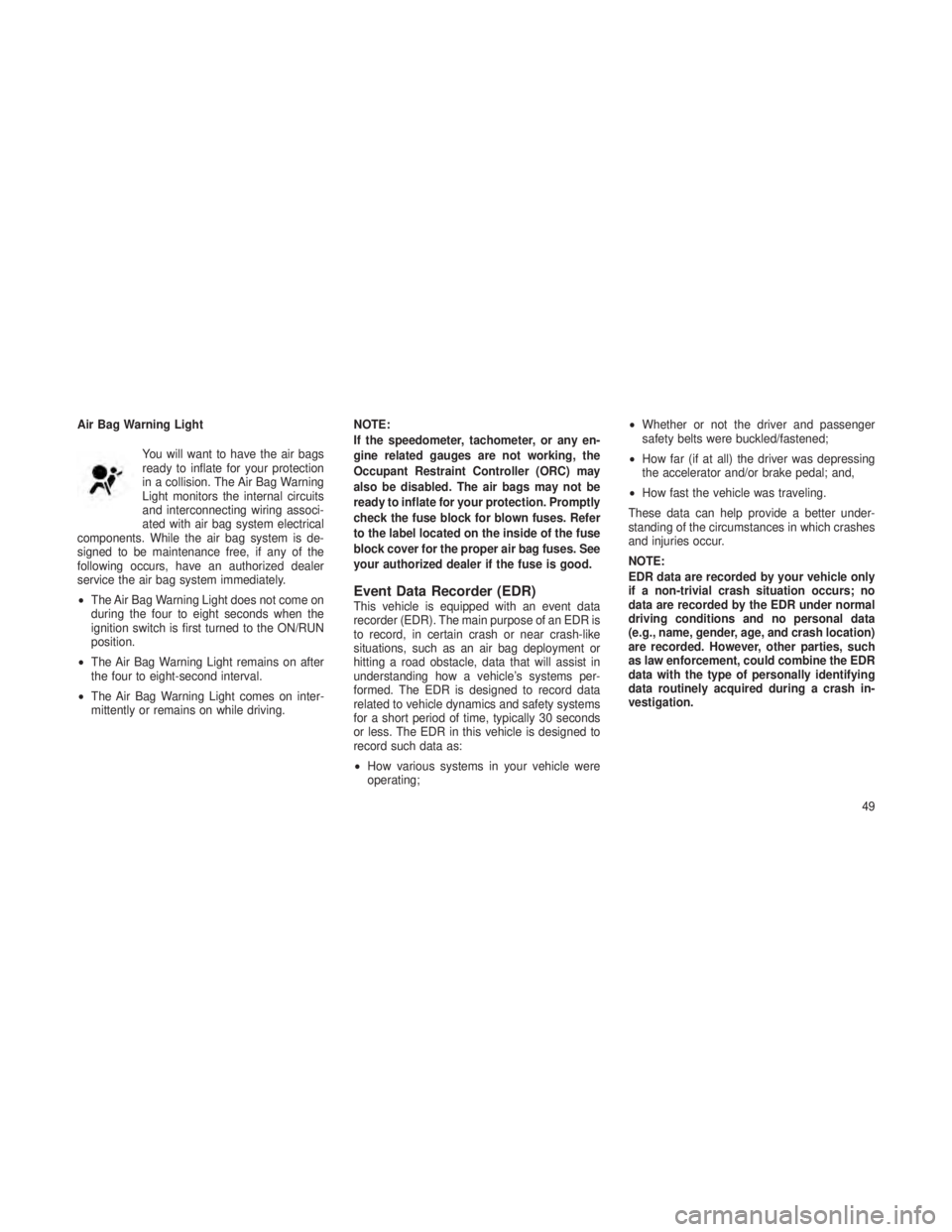
Air Bag Warning LightYou will want to have the air bags
ready to inflate for your protection
in a collision. The Air Bag Warning
Light monitors the internal circuits
and interconnecting wiring associ-
ated with air bag system electrical
components. While the air bag system is de-
signed to be maintenance free, if any of the
following occurs, have an authorized dealer
service the air bag system immediately.
• The Air Bag Warning Light does not come on
during the four to eight seconds when the
ignition switch is first turned to the ON/RUN
position.
• The Air Bag Warning Light remains on after
the four to eight-second interval.
• The Air Bag Warning Light comes on inter-
mittently or remains on while driving. NOTE:
If the speedometer, tachometer, or any en-
gine related gauges are not working, the
Occupant Restraint Controller (ORC) may
also be disabled. The air bags may not be
ready to inflate for your protection. Promptly
check the fuse block for blown fuses. Refer
to the label located on the inside of the fuse
block cover for the proper air bag fuses. See
your authorized dealer if the fuse is good.
Event Data Recorder (EDR)This vehicle is equipped with an event data
recorder (EDR). The main purpose of an EDR is
to record, in certain crash or near crash-like
situations, such as an air bag deployment or
hitting a road obstacle, data that will assist in
understanding how a vehicle’s systems per-
formed. The EDR is designed to record data
related to vehicle dynamics and safety systems
for a short period of time, typically 30 seconds
or less. The EDR in this vehicle is designed to
record such data as:
•
How various systems in your vehicle were
operating; •
Whether or not the driver and passenger
safety belts were buckled/fastened;
• How far (if at all) the driver was depressing
the accelerator and/or brake pedal; and,
• How fast the vehicle was traveling.
These data can help provide a better under-
standing of the circumstances in which crashes
and injuries occur.
NOTE:
EDR data are recorded by your vehicle only
if a non-trivial crash situation occurs; no
data are recorded by the EDR under normal
driving conditions and no personal data
(e.g., name, gender, age, and crash location)
are recorded. However, other parties, such
as law enforcement, could combine the EDR
data with the type of personally identifying
data routinely acquired during a crash in-
vestigation.
49
Page 54 of 408
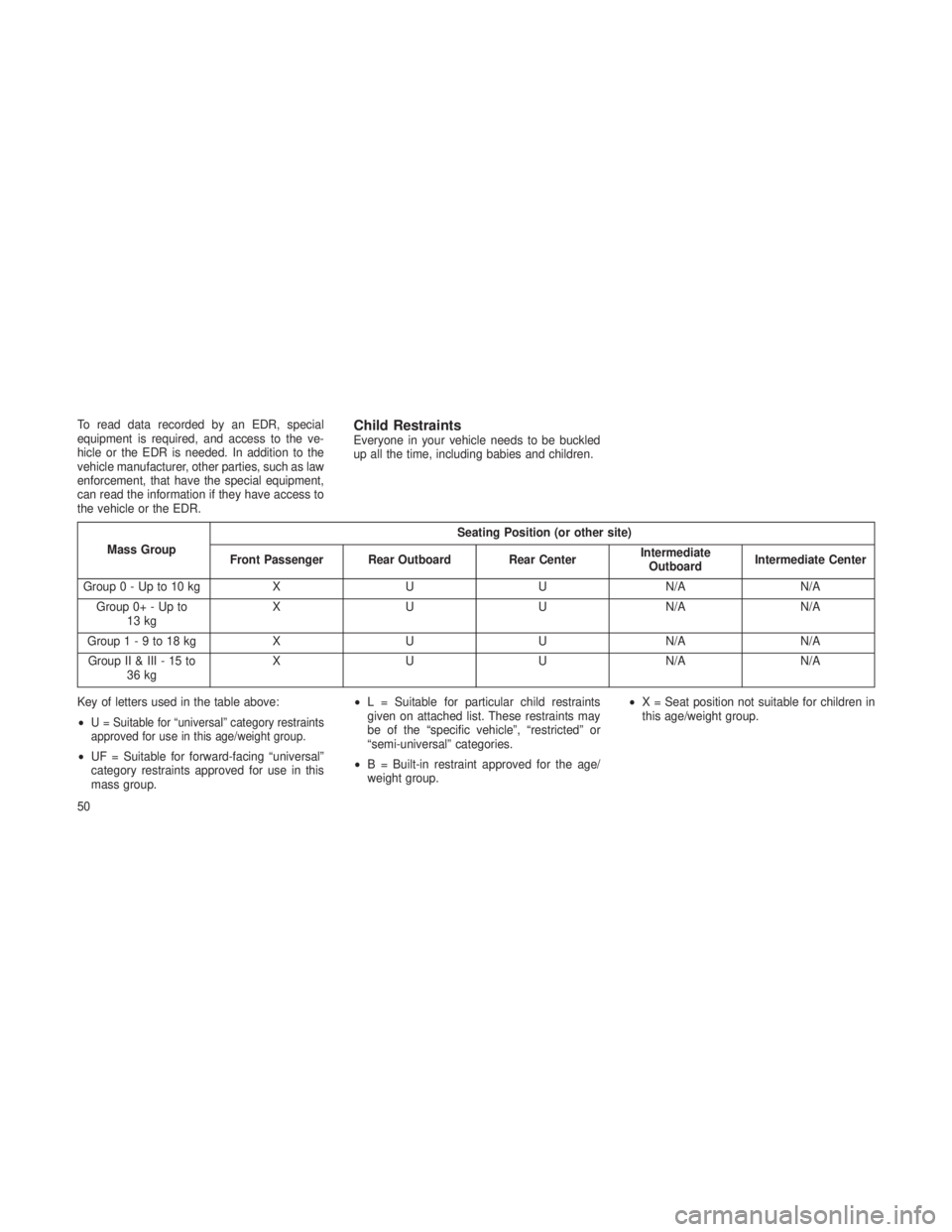
To read data recorded by an EDR, special
equipment is required, and access to the ve-
hicle or the EDR is needed. In addition to the
vehicle manufacturer, other parties, such as law
enforcement, that have the special equipment,
can read the information if they have access to
the vehicle or the EDR.Child RestraintsEveryone in your vehicle needs to be buckled
up all the time, including babies and children.
Mass GroupSeating Position (or other site)
Front Passenger Rear Outboard Rear Center Intermediate
Outboard Intermediate Center
Group0-Upto10kg XU UN/A N/A
Group 0+ - Up to 13 kg X
U UN/A N/A
Group1-9to18kg XU UN/A N/A
Group II & III - 15 to 36 kg X
U UN/A N/A
Key of letters used in the table above:
•
U = Suitable for “universal” category restraints
approved for use in this age/weight group.
• UF = Suitable for forward-facing “universal”
category restraints approved for use in this
mass group. •
L = Suitable for particular child restraints
given on attached list. These restraints may
be of the “specific vehicle”, “restricted” or
“semi-universal” categories.
• B = Built-in restraint approved for the age/
weight group. •
X = Seat position not suitable for children in
this age/weight group.
50
Page 55 of 408
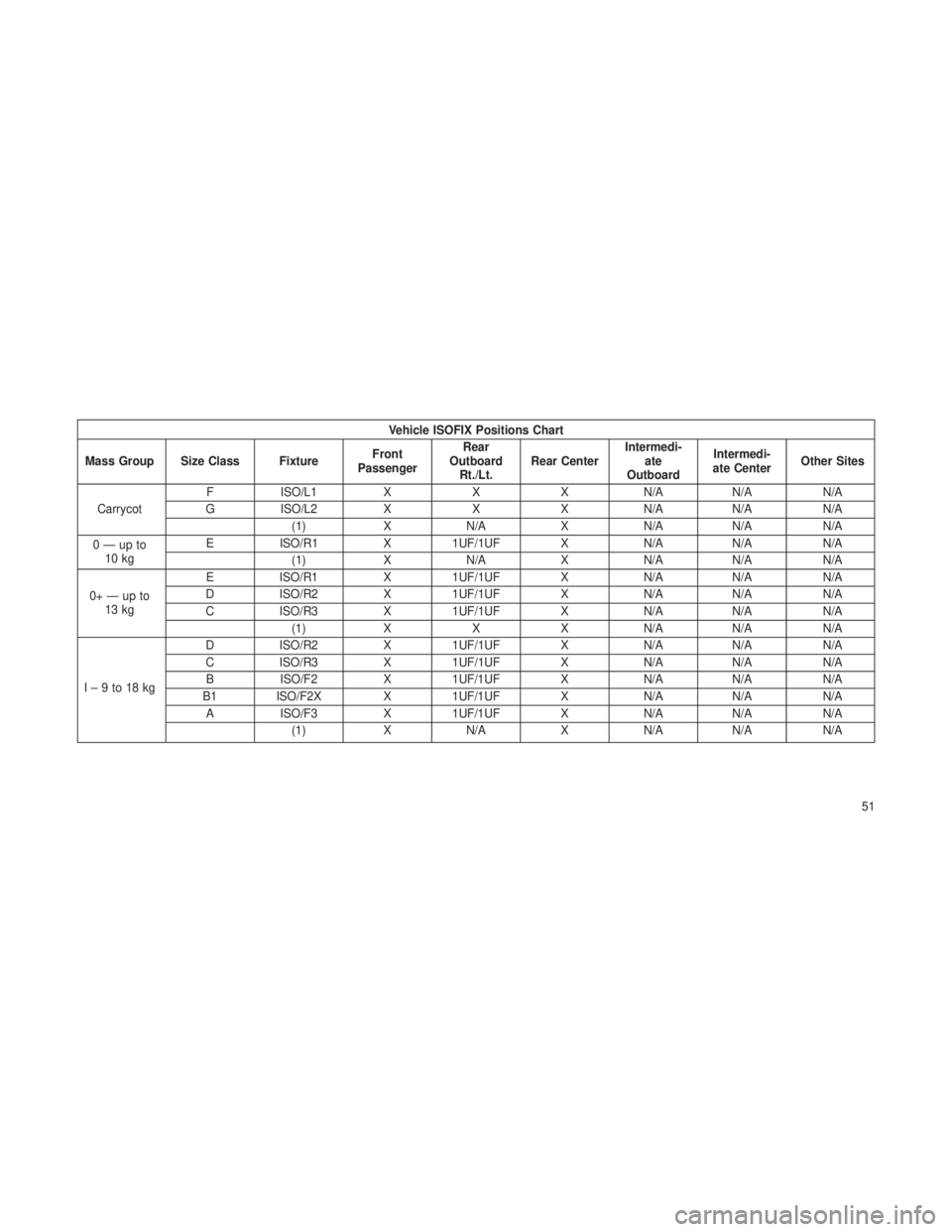
Vehicle ISOFIX Positions Chart
Mass Group Size Class Fixture Front
Passenger Rear
Outboard Rt./Lt. Rear Center Intermedi-
ate
Outboard Intermedi-
ate Center Other Sites
Carrycot F
ISO/L1 XXXN/A N/A N/A
G ISO/L2 XXXN/A N/A N/A
(1) XN/A XN/A N/A N/A
0—upto 10 kg E
ISO/R1 X1UF/1UF XN/A N/A N/A
(1) XN/A XN/A N/A N/A
0+—upto 13 kg E
ISO/R1 X1UF/1UF XN/A N/A N/A
D ISO/R2 X1UF/1UF XN/A N/A N/A
C ISO/R3 X1UF/1UF XN/A N/A N/A
(1) XXXN/A N/A N/A
I–9to18kg D
ISO/R2 X1UF/1UF XN/A N/A N/A
C ISO/R3 X1UF/1UF XN/A N/A N/A
B ISO/F2 X1UF/1UF XN/A N/A N/A
B1 ISO/F2X X1UF/1UF XN/A N/A N/A
A ISO/F3 X1UF/1UF XN/A N/A N/A
(1) XN/A XN/A N/A N/A
51
Page 56 of 408
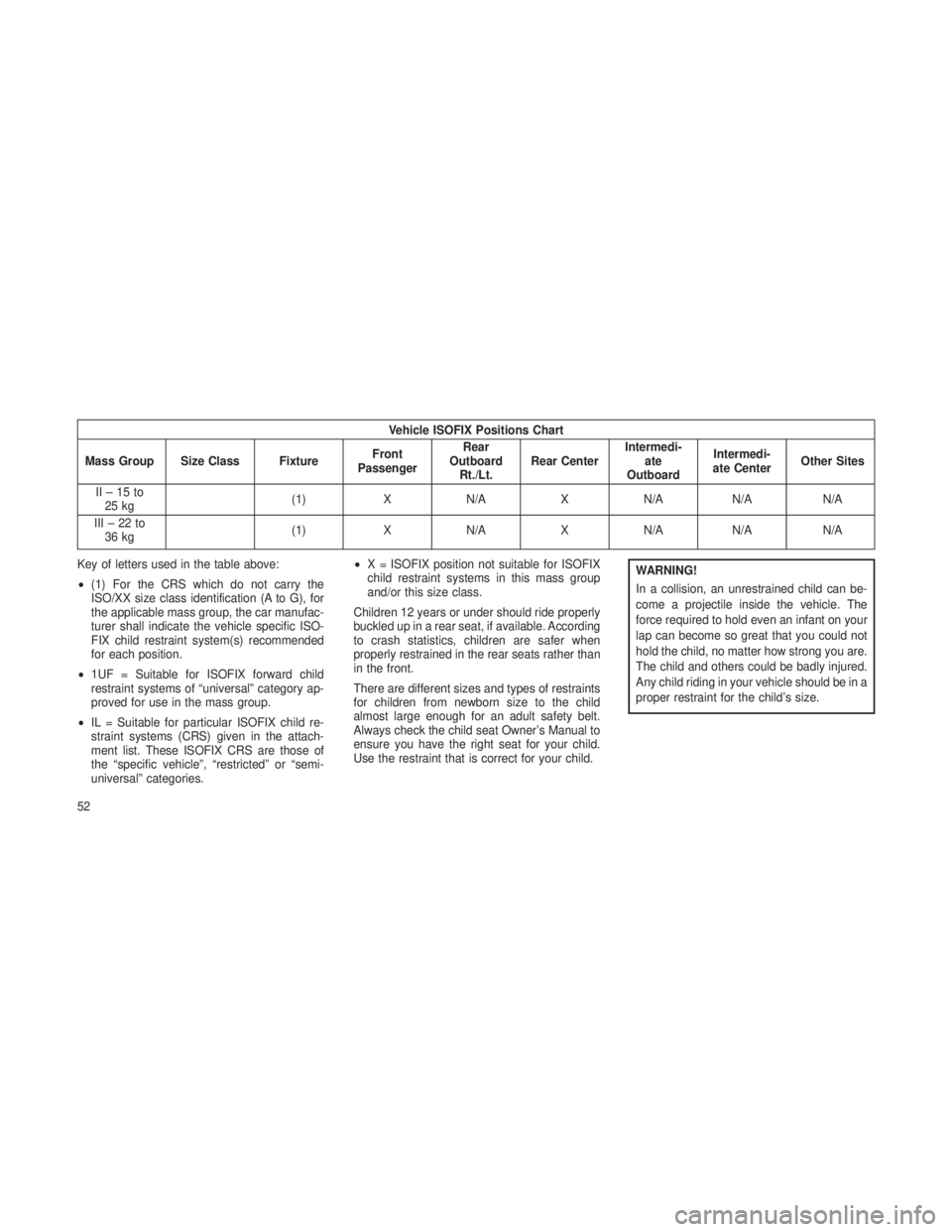
Vehicle ISOFIX Positions Chart
Mass Group Size Class Fixture Front
Passenger Rear
Outboard Rt./Lt. Rear Center Intermedi-
ate
Outboard Intermedi-
ate Center Other Sites
II–15to 25 kg (1)
XN/A XN/A N/A N/A
III–22to 36 kg (1) X N/A X N/A N/A N/A
Key of letters used in the table above:
• (1) For the CRS which do not carry the
ISO/XX size class identification (A to G), for
the applicable mass group, the car manufac-
turer shall indicate the vehicle specific ISO-
FIX child restraint system(s) recommended
for each position.
• 1UF = Suitable for ISOFIX forward child
restraint systems of “universal” category ap-
proved for use in the mass group.
• IL = Suitable for particular ISOFIX child re-
straint systems (CRS) given in the attach-
ment list. These ISOFIX CRS are those of
the “specific vehicle”, “restricted” or “semi-
universal” categories. •
X = ISOFIX position not suitable for ISOFIX
child restraint systems in this mass group
and/or this size class.
Children 12 years or under should ride properly
buckled up in a rear seat, if available. According
to crash statistics, children are safer when
properly restrained in the rear seats rather than
in the front.
There are different sizes and types of restraints
for children from newborn size to the child
almost large enough for an adult safety belt.
Always check the child seat Owner’s Manual to
ensure you have the right seat for your child.
Use the restraint that is correct for your child.
WARNING!
In a collision, an unrestrained child can be-
come a projectile inside the vehicle. The
force required to hold even an infant on your
lap can become so great that you could not
hold the child, no matter how strong you are.
The child and others could be badly injured.
Any child riding in your vehicle should be in a
proper restraint for the child’s size.
52
Page 57 of 408
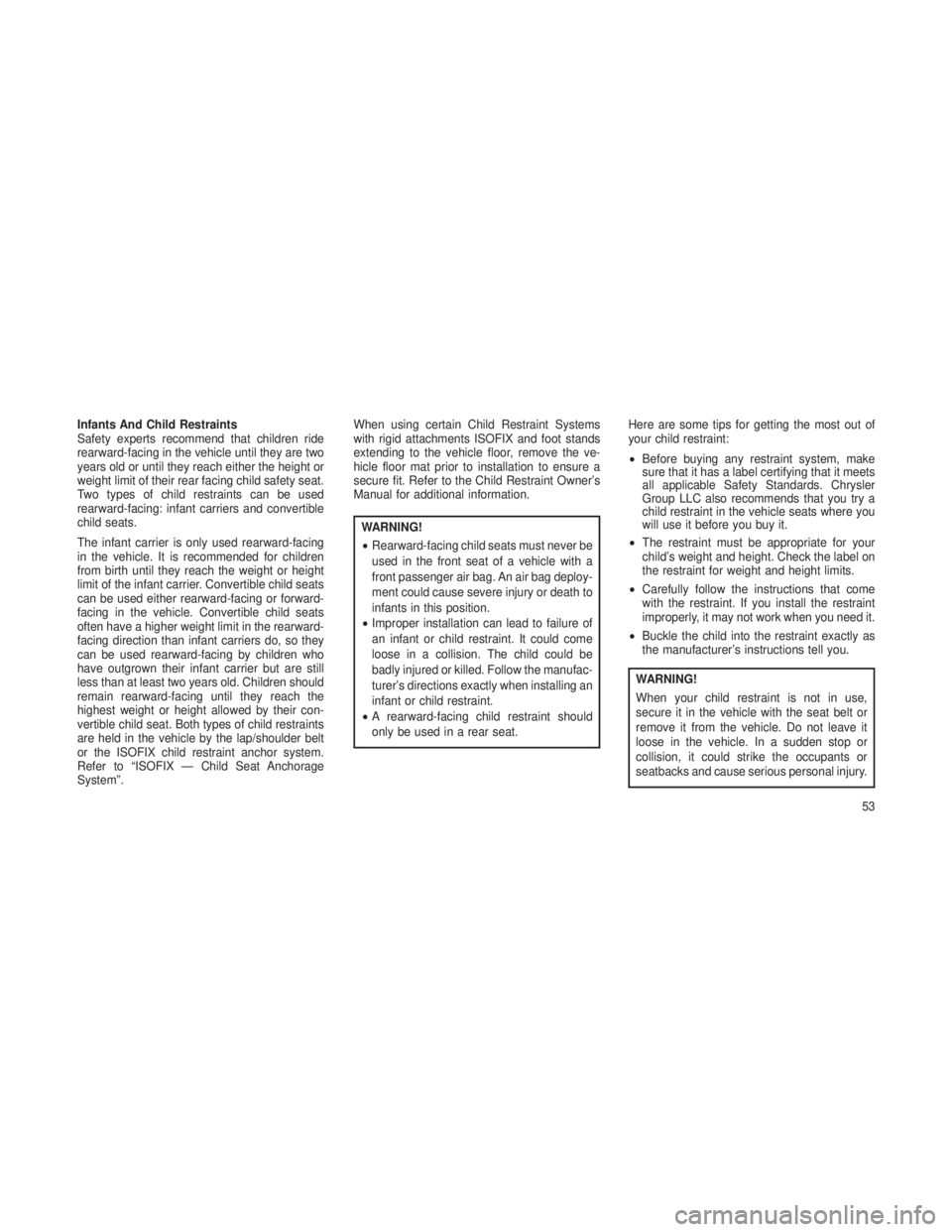
Infants And Child Restraints
Safety experts recommend that children ride
rearward-facing in the vehicle until they are two
years old or until they reach either the height or
weight limit of their rear facing child safety seat.
Two types of child restraints can be used
rearward-facing: infant carriers and convertible
child seats.
The infant carrier is only used rearward-facing
in the vehicle. It is recommended for children
from birth until they reach the weight or height
limit of the infant carrier. Convertible child seats
can be used either rearward-facing or forward-
facing in the vehicle. Convertible child seats
often have a higher weight limit in the rearward-
facing direction than infant carriers do, so they
can be used rearward-facing by children who
have outgrown their infant carrier but are still
less than at least two years old. Children should
remain rearward-facing until they reach the
highest weight or height allowed by their con-
vertible child seat. Both types of child restraints
are held in the vehicle by the lap/shoulder belt
or the ISOFIX child restraint anchor system.
Refer to “ISOFIX — Child Seat Anchorage
System”.When using certain Child Restraint Systems
with rigid attachments ISOFIX and foot stands
extending to the vehicle floor, remove the ve-
hicle floor mat prior to installation to ensure a
secure fit. Refer to the Child Restraint Owner’s
Manual for additional information.
WARNING!
•
Rearward-facing child seats must never be
used in the front seat of a vehicle with a
front passenger air bag. An air bag deploy-
ment could cause severe injury or death to
infants in this position.
• Improper installation can lead to failure of
an infant or child restraint. It could come
loose in a collision. The child could be
badly injured or killed. Follow the manufac-
turer’s directions exactly when installing an
infant or child restraint.
• A rearward-facing child restraint should
only be used in a rear seat. Here are some tips for getting the most out of
your child restraint:
•
Before buying any restraint system, make
sure that it has a label certifying that it meets
all applicable Safety Standards. Chrysler
Group LLC also recommends that you try a
child restraint in the vehicle seats where you
will use it before you buy it.
• The restraint must be appropriate for your
child’s weight and height. Check the label on
the restraint for weight and height limits.
• Carefully follow the instructions that come
with the restraint. If you install the restraint
improperly, it may not work when you need it.
• Buckle the child into the restraint exactly as
the manufacturer’s instructions tell you.
WARNING!
When your child restraint is not in use,
secure it in the vehicle with the seat belt or
remove it from the vehicle. Do not leave it
loose in the vehicle. In a sudden stop or
collision, it could strike the occupants or
seatbacks and cause serious personal injury.
53
Page 58 of 408
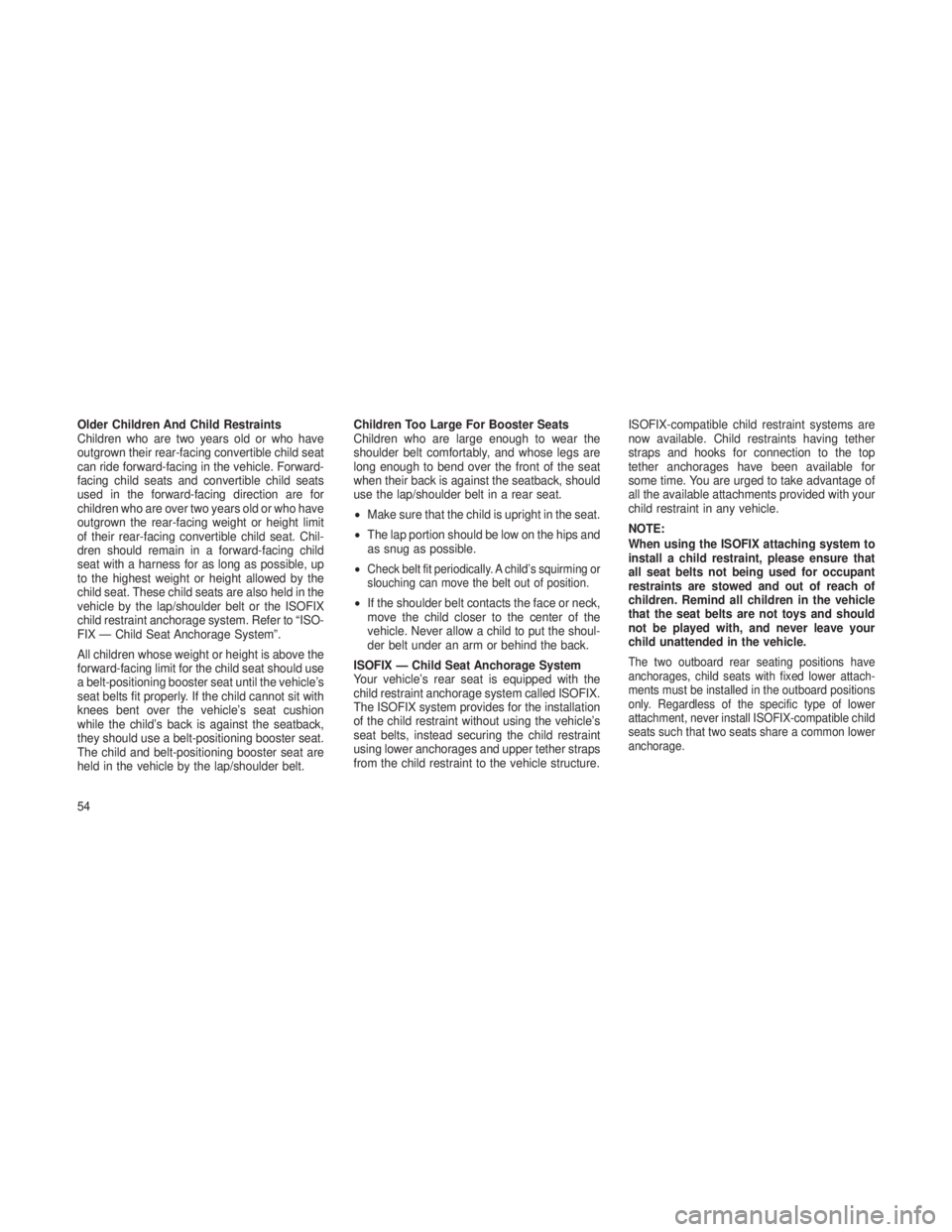
Older Children And Child Restraints
Children who are two years old or who have
outgrown their rear-facing convertible child seat
can ride forward-facing in the vehicle. Forward-
facing child seats and convertible child seats
used in the forward-facing direction are for
children who are over two years old or who have
outgrown the rear-facing weight or height limit
of their rear-facing convertible child seat. Chil-
dren should remain in a forward-facing child
seat with a harness for as long as possible, up
to the highest weight or height allowed by the
child seat. These child seats are also held in the
vehicle by the lap/shoulder belt or the ISOFIX
child restraint anchorage system. Refer to “ISO-
FIX — Child Seat Anchorage System”.
All children whose weight or height is above the
forward-facing limit for the child seat should use
a belt-positioning booster seat until the vehicle’s
seat belts fit properly. If the child cannot sit with
knees bent over the vehicle’s seat cushion
while the child’s back is against the seatback,
they should use a belt-positioning booster seat.
The child and belt-positioning booster seat are
held in the vehicle by the lap/shoulder belt.Children Too Large For Booster Seats
Children who are large enough to wear the
shoulder belt comfortably, and whose legs are
long enough to bend over the front of the seat
when their back is against the seatback, should
use the lap/shoulder belt in a rear seat.
•
Make sure that the child is upright in the seat.
• The lap portion should be low on the hips and
as snug as possible.
•
Check belt fit periodically. A child’s squirming or
slouching can move the belt out of position.
• If the shoulder belt contacts the face or neck,
move the child closer to the center of the
vehicle. Never allow a child to put the shoul-
der belt under an arm or behind the back.
ISOFIX — Child Seat Anchorage System
Your vehicle’s rear seat is equipped with the
child restraint anchorage system called ISOFIX.
The ISOFIX system provides for the installation
of the child restraint without using the vehicle’s
seat belts, instead securing the child restraint
using lower anchorages and upper tether straps
from the child restraint to the vehicle structure. ISOFIX-compatible child restraint systems are
now available. Child restraints having tether
straps and hooks for connection to the top
tether anchorages have been available for
some time. You are urged to take advantage of
all the available attachments provided with your
child restraint in any vehicle.
NOTE:
When using the ISOFIX attaching system to
install a child restraint, please ensure that
all seat belts not being used for occupant
restraints are stowed and out of reach of
children. Remind all children in the vehicle
that the seat belts are not toys and should
not be played with, and never leave your
child unattended in the vehicle.
The two outboard rear seating positions have
anchorages, child seats with fixed lower attach-
ments must be installed in the outboard positions
only. Regardless of the specific type of lower
attachment, never install ISOFIX-compatible child
seats such that two seats share a common lower
anchorage.
54
Page 59 of 408
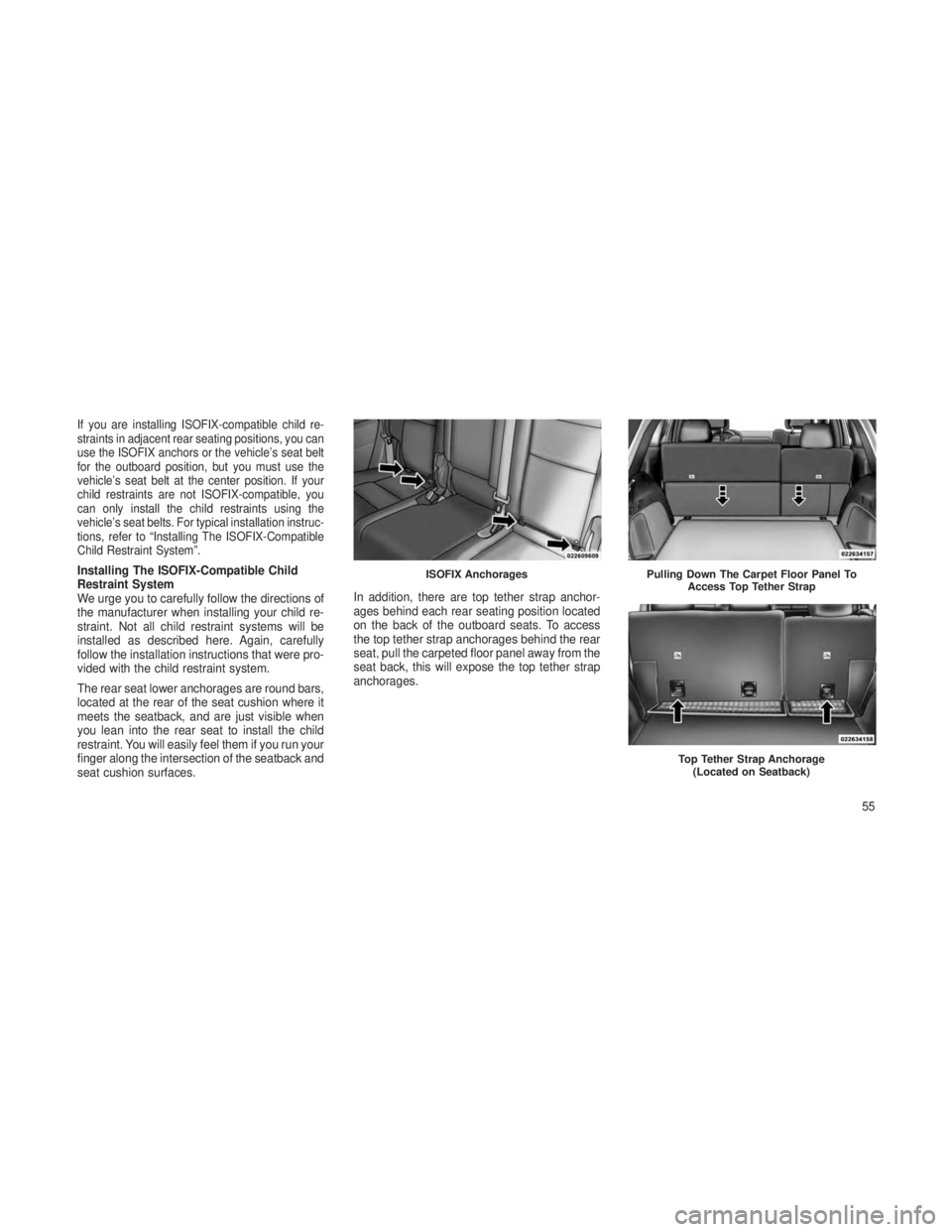
If you are installing ISOFIX-compatible child re-
straints in adjacent rear seating positions, you can
use the ISOFIX anchors or the vehicle’s seat belt
for the outboard position, but you must use the
vehicle’s seat belt at the center position. If your
child restraints are not ISOFIX-compatible, you
can only install the child restraints using the
vehicle’s seat belts. For typical installation instruc-
tions, refer to “Installing The ISOFIX-Compatible
Child Restraint System”.
Installing The ISOFIX-Compatible Child
Restraint System
We urge you to carefully follow the directions of
the manufacturer when installing your child re-
straint. Not all child restraint systems will be
installed as described here. Again, carefully
follow the installation instructions that were pro-
vided with the child restraint system.
The rear seat lower anchorages are round bars,
located at the rear of the seat cushion where it
meets the seatback, and are just visible when
you lean into the rear seat to install the child
restraint. You will easily feel them if you run your
finger along the intersection of the seatback and
seat cushion surfaces.In addition, there are top tether strap anchor-
ages behind each rear seating position located
on the back of the outboard seats. To access
the top tether strap anchorages behind the rear
seat, pull the carpeted floor panel away from the
seat back, this will expose the top tether strap
anchorages.ISOFIX AnchoragesPulling Down The Carpet Floor Panel To
Access Top Tether Strap
Top Tether Strap Anchorage(Located on Seatback)
55
Page 60 of 408
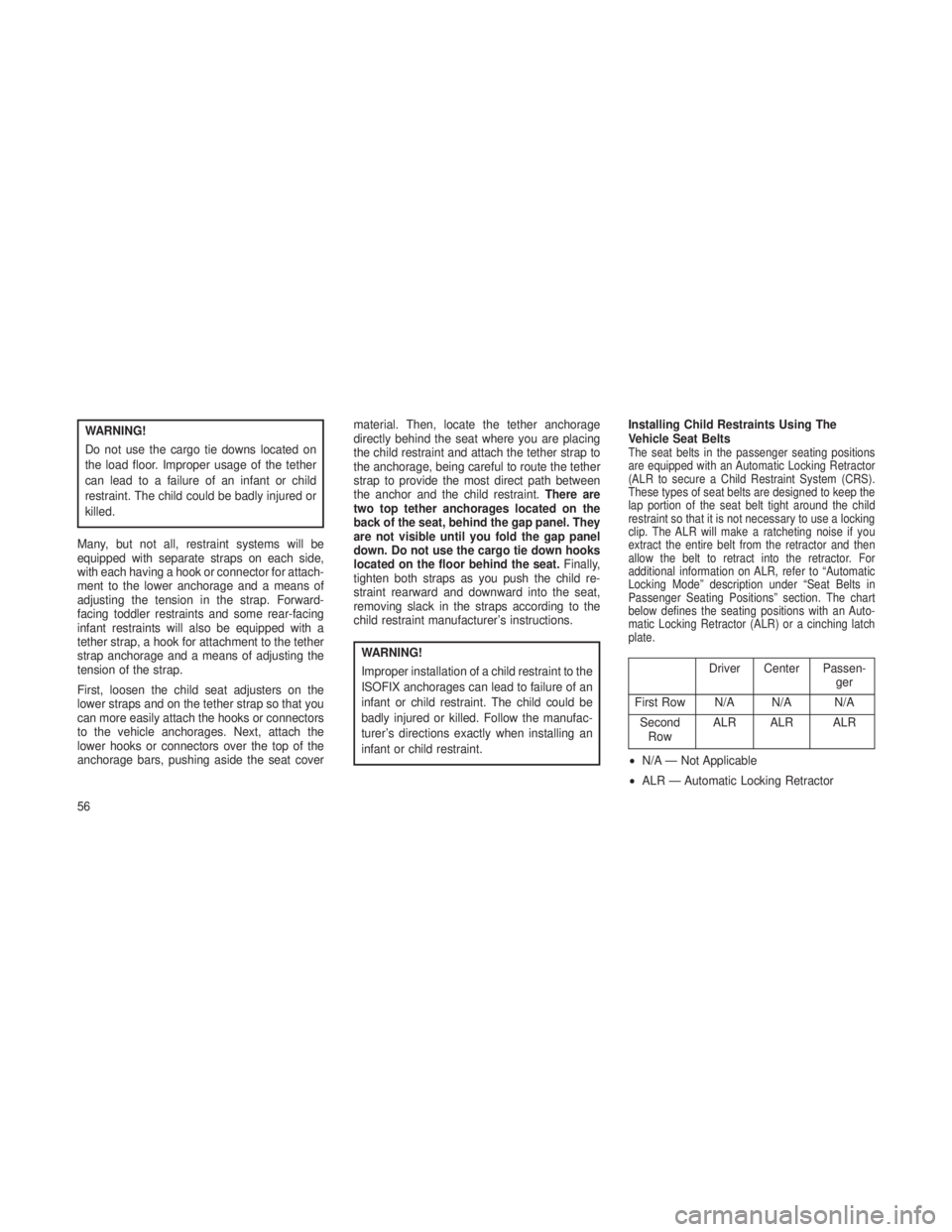
WARNING!
Do not use the cargo tie downs located on
the load floor. Improper usage of the tether
can lead to a failure of an infant or child
restraint. The child could be badly injured or
killed.
Many, but not all, restraint systems will be
equipped with separate straps on each side,
with each having a hook or connector for attach-
ment to the lower anchorage and a means of
adjusting the tension in the strap. Forward-
facing toddler restraints and some rear-facing
infant restraints will also be equipped with a
tether strap, a hook for attachment to the tether
strap anchorage and a means of adjusting the
tension of the strap.
First, loosen the child seat adjusters on the
lower straps and on the tether strap so that you
can more easily attach the hooks or connectors
to the vehicle anchorages. Next, attach the
lower hooks or connectors over the top of the
anchorage bars, pushing aside the seat cover material. Then, locate the tether anchorage
directly behind the seat where you are placing
the child restraint and attach the tether strap to
the anchorage, being careful to route the tether
strap to provide the most direct path between
the anchor and the child restraint.
There are
two top tether anchorages located on the
back of the seat, behind the gap panel. They
are not visible until you fold the gap panel
down. Do not use the cargo tie down hooks
located on the floor behind the seat. Finally,
tighten both straps as you push the child re-
straint rearward and downward into the seat,
removing slack in the straps according to the
child restraint manufacturer’s instructions.
WARNING!
Improper installation of a child restraint to the
ISOFIX anchorages can lead to failure of an
infant or child restraint. The child could be
badly injured or killed. Follow the manufac-
turer’s directions exactly when installing an
infant or child restraint. Installing Child Restraints Using The
Vehicle Seat Belts
The seat belts in the passenger seating positions
are equipped with an Automatic Locking Retractor
(ALR to secure a Child Restraint System (CRS).
These types of seat belts are designed to keep the
lap portion of the seat belt tight around the child
restraint so that it is not necessary to use a locking
clip. The ALR will make a ratcheting noise if you
extract the entire belt from the retractor and then
allow the belt to retract into the retractor. For
additional information on ALR, refer to “Automatic
Locking Mode” description under “Seat Belts in
Passenger Seating Positions” section. The chart
below defines the seating positions with an Auto-
matic Locking Retractor (ALR) or a cinching latch
plate.
Driver Center Passen-
ger
First Row N/A N/A N/A Second Row ALR ALR ALR
• N/A — Not Applicable
• ALR — Automatic Locking Retractor
56